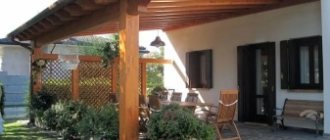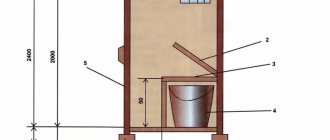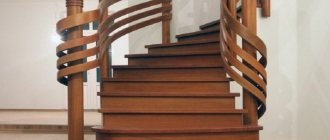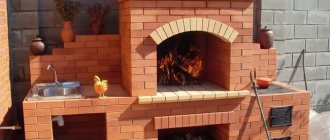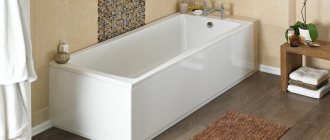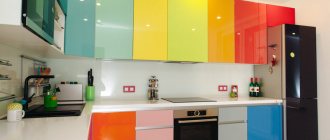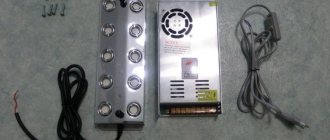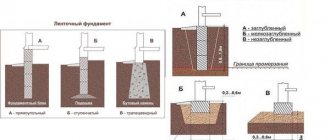A cover for a pool in a country house, although not one of the mandatory elements of this hydraulic structure, is still a fairly popular addition. If chosen and installed correctly, the roof solves a large number of problems associated with pool maintenance. To make it clear what needs to be taken into account when ordering a roof for a pool, the article contains information about the types of such shelters and the features of their installation
Cover for a pool in a summer cottage Source zenac.qogilen.ru.net
Pros and cons of a pool under polycarbonate
To figure out whether a roof is needed over the pool, you need to carefully analyze the positive and negative aspects of the structure.
Pros:
- An open canopy partially prevents water pollution from leaves, droppings of flying birds and other large debris. If the polycarbonate roof smoothly merges with the walls, forming a closed structure, then the pool is maximally protected even from wind blowing dust.
- The canopy allows you to use the pool in inclement weather. Enclosed structures provide favorable conditions for relaxation at the dacha even in the autumn.
- A polycarbonate roof allows light to pass through, diffuses it, and blocks UV rays. You can sunbathe safely for a long time under a canopy at your dacha.
- The closed type of canopy reduces the cooling rate of the water in the pool. The owner of a dacha reduces the cost of heating it.
- The roof reduces the rate of water evaporation. The pool will have to be refilled less often.
- A canopy, even if it is open, protects the pool from precipitation at the dacha in winter and autumn.
Minuses:
- Covering your pool with polycarbonate will require additional investment.
- The roof requires additional care. If the snow is not cleared off in winter, the polycarbonate will fail under heavy weight. The procedure is often impossible, since no one lives at the dacha in winter. It is necessary to come specially after each snowfall.
Despite two serious disadvantages, the canopy has more advantages. Because of the disadvantages, you should not refuse to build a useful structure at your dacha.
Important! The roof reduces the likelihood of the harmful effects of snow and rain on the bowl, communications and pool equipment.
Unique construction technology
Specialists of the Vseslav group of companies have technology that allows them to quickly and without complex foundations create bowls of any size, shape and with any bottom profile. This is achieved by installing the pool bowl directly on the mainland soil. To construct the bowl, permanent reinforced plastic formwork is used, which remains inside the structure and has a perfectly smooth and even surface ready for cladding.
Swimming pool in the building
With this method of constructing a bowl, all subsequent stages of pool construction are no less easily and quickly carried out. Thus, cladding the walls and the bottom of the bowl does not require additional work and hours associated with leveling, plastering and treatment with special waterproofing compounds, since a plastic, economical and hygienic PVC film is applied to absolutely smooth plastic surfaces, which is both a facing and a waterproofing coating .
This feature of the technology allows us to fulfill almost any plan of the designer and architect, as well as any whim of the customer. This means that building the most exquisite exclusive pool and fitting it into any room is not difficult for the specialists of the Vseslav group of companies. The pool can be located in a separate building, in an extension to a residential building, under the roof of a special pavilion, or simply in the open air.
Types of polycarbonate pool canopies
All canopies are conditionally divided into two groups:
- Stationary structure. It is a capital building on a foundation. The roof often blends seamlessly into the walls, creating a complete pool cover. The area of a stationary canopy is larger than the dimensions of the pool. Recreation areas are organized under the shelter, furniture and flowerpots with ornamental plants are installed. If heating is installed inside the closed shed, the pool at the dacha can be used all year round or until severe frosts occur.
- A telescopic roof is considered a mobile structure. The canopy consists of several sections of different sizes. They move along guide rails. If necessary, the pool can be fully opened, partially opened or closed. During opening, each smaller polycarbonate section slides under the larger section.
In turn, stationary and telescopic canopies are divided into two more groups:
The roofs are closed and smoothly merge into the walls. Above the pool at the dacha you get a full-fledged covered structure made of polycarbonate. The resting place is completely protected from wind and precipitation.
Open canopies are a simple polycarbonate structure without walls. Only the roof protects the pool. Sometimes the canopy is made partially open with one wall, which is placed on the windy side.
Of the minor classifications, the next difference is height. The owner of the dacha maintains this parameter at his own discretion. Low canopies are created only to cover the pool from pollution. People can move under tall structures.
Roofs are distinguished by shape. Usually they follow the outline of the font. For example, a polycarbonate cover for a round pool has a similar circle shape. The roof itself is made single or gable, arched, asymmetrical or another type. Depending on the polycarbonate used for glazing, canopies vary in color. Transparent roofs are considered a classic, but if desired, you can install a colored one at your dacha, for example, blue.
Advice! The polycarbonate cover over the pool should be harmoniously combined in shape and color with the architectural ensemble and fit harmoniously into the landscape design.
Do you need a fence?
A roof for a round pool also requires a certain safety zone, that is, an area around the pool with protective nets or walls - primarily for the safe stay of children in the area next to the pond. And if you decide to protect your children from unplanned diving into the pool, then it is advisable to at least erect a mesh barrier around the fence.
The design of a lightweight fence consists of several metal sections consisting of a frame frame on which a galvanized metal mesh with a rectangular cell is stretched. You choose the sizes yourself. The material should be made of stainless steel, preferably metal pipes of round and rectangular cross-section.
After digging shallow trenches on the ground, concrete blocks are installed across the fence. The barrier pins are inserted into holes in these concrete blocks.
Which polycarbonate is better for a swimming pool?
You should choose polycarbonate for canopy glazing at the design stage of the structure. The design of the sheathing will depend on this. There are two types of material:
- Monolithic polycarbonate, has no cells. Externally, the material resembles glass. The sheets are characterized by increased strength and will last 3 times longer than their cellular counterpart. In terms of cost, the material will cost more for the owner of the dacha. Due to the greater weight, reinforced sheathing will be required. Monolithic polycarbonate is optimal for glazing canopies with even slopes, but can be used for roofs of complex shapes. From the outside, the pool cover at the dacha will resemble a glass structure.
- Cellular polycarbonate consists of many longitudinal channels. They are shaped like a honeycomb. This is where the name “cellular polycarbonate” comes from. The material for the pool roof is budget-friendly and has long been popular among dacha owners. Polycarbonate is lightweight, low cost, but has a short service life. Due to the voids inside, the sheets can withstand a small load. Large accumulations of snow will cause cellular polycarbonate to fail if the owner of the dacha does not clean the roof in time. The sheets have good flexibility and are ideal for glazing arched and round canopies.
To build a reliable polycarbonate pool cover with your own hands, you need to choose the right material thickness. Here, the snow load characteristic of a particular region, roof shape, size, and sheathing parameters are taken into account. For roof glazing, sheets of thickness 8, 10 and 16 mm are used. If the canopy at the dacha is closed, then you will need more material for glazing the walls. Due to the minimum load, polycarbonate with a thickness of 6 mm will be used here.
In the video, the rules for choosing polycarbonate for a canopy:
Work order
To build a pool, they purchase plastic water pipes, fittings, cables and pipes for it, waterproof lamps (optional) and serious equipment - a skimmer for filtration, a circulation pump.
A greenhouse assembled with your own hands does not always turn out the way the master intended, so in the case of a swimming pool it makes sense to buy a finished product, which will only have to be assembled and fixed on a strip foundation. The minimum distance between it and the sides of the bowl is 300 mm. Bigger is better, since there should be enough passage even for one person.
Installation of the finished bowl
First they do excavation work - they dig a pit intended for the bowl and trenches for the cable. The first one should have dimensions that exceed all the parameters of the finished bowl by 250-300 mm. The bottom is compacted and lined with geotextile; this fabric will protect the soil from washing out. Then a thick sand cushion is poured, it is poured with plenty of water, and compacted well. Next, the walls are covered: they use boards (25 mm) treated with antiseptic impregnation.
A bowl is lowered into the pit, the outside of the side is insulated with polystyrene foam, the gaps between the boards are covered in layers with fine sand, each “portion” is carefully compacted. Another option is to fill the space with concrete, but this operation is done simultaneously with water entering the pool. In this way, possible deflections of the bowl are avoided; this is achieved by equalizing the pressure difference.
Then they lay the pipes in trenches, bring them to the bowl, and treat all joints with sealant. The trenches are dug in, and the font itself is protected from debris by covering it with shields made from the same boards.
Construction made of polystyrene foam blocks
This option is a compromise between a concrete and a commercial bowl. Expanded polystyrene is lightweight but durable, well ventilated, but has good thermal insulation characteristics, so the water will remain warm even at night. Multi-level bowls and stairs are often made from polystyrene foam blocks, designed for convenient entry.
To construct the bowl, large-format blocks are used, their size is XXL. Each of them has grooves that allow fastening structural elements with reinforcement. Expanded polystyrene is easily cut with a hacksaw, so there are no difficulties with fitting them. The craftsman will only have to cut holes for the pipes (for filtration, drainage). They are insulated with polyurethane foam.
After assembling and installing the structure in the pit, rods are inserted into the voids - holes specially made for vertical reinforcement - which must be connected
Dilute the solution, pour it into the interblock space, paying special attention to the joints. Then the bowl is left alone for several days, and after drying, it is meticulously inspected - an inspection is carried out, identifying potential cracks
If there are any, the cracks are drilled out a little and treated with putty.
After it dries, the holes are filled with a solution, which is left until final hardening, then the surfaces are plastered. The bottom and walls of the finished bowl are covered with waterproofing material, PVC facing film, and anti-slip tiles. The perimeter edges are decorated with ceramic tiles.
Greenhouse works
Referring to the frame drawings, mark the soil around the pool. Inside the resulting contour, a layer of soil is removed, its thickness is 200 mm. A trench is dug around the perimeter for a strip base (500 mm). The formwork is installed there, then the structure is reinforced with a reinforcing belt. Fill the trench with concrete, then, without waiting for complete setting, insert the embedded parts intended for the racks of the greenhouse.
After half a month, the space between the base and the bowl is filled with sand and gravel, and paving slabs are laid on them. Consulting the instructions, install the frame using bolts or welding. The finished “skeleton” is coated with an anti-corrosion compound and painted. Then, using thermal washers, polycarbonate sheets are attached to it, connecting profiles are installed at the joints, and a sliding mechanism is mounted. The last stage is the installation of the door, installation of lamps and heating devices.
A swimming pool in a greenhouse is a dream that can become a reality, but it will require a lot of effort to make it come true. Many experts argue that building a bowl on your own is not the best idea, but they favor the assembly of greenhouses and pavilions. Therefore, before deciding on an “adventure”, it is better to see how other masters accomplish this feat. For example, in this video:
Polycarbonate color for pool cover
Polycarbonate is produced in different colors. There are no special requirements for selection here. The owner of the dacha, at his discretion, glazes the roof with yellow, red, blue, green or other colored sheets.
Transparent material is considered a classic. It is most often preferred for awnings as it does not distort natural light. Under a roof made of colored polycarbonate you can get a special atmosphere. For example, relaxing near a pool where the space is illuminated by blue or red light is difficult. The eyes get tired quickly, it puts pressure on the head, creating a feeling of discomfort.
How to choose a pavilion
Since these structures come in different shapes and heights, you should buy one that completely covers the bathing bowl and part of the base near it.
The main mistakes that buyers make when choosing:
- The shelter does not meet the parameters;
- The canopy is not suitable for the climatic conditions;
- Choosing an unscrupulous seller.
When planning to purchase a shelter for a home bath, you need to consider:
- Height of the building.
Are you planning to install a recreation area or is the main task to hide water from debris, dust, leaves and prevent its rapid evaporation? If you just need to make a roof, then a low shelter is enough: you can swim in the font for your own pleasure, just without acrobatic jumps. To set up a spa area, you will need a high pavilion that will serve as a gazebo or canopy on a picnic area.
- Shape and size.
Everything is simple here: a dome-shaped canopy is unlikely to be suitable for a rectangular model. For a round bowl, an asymmetrical pavilion is unlikely to be needed, unless the owners of the site intend to create a closed recreation area, when there is a swimming pool, a dance floor, a workout room, and a cocktail bar under the roof.
- Type: mobile, stationary.
Each of the pavilions is comfortable and functional. However, it is important to understand how the pool will be used, for how long and in what area. For example, for a small site, a mobile canopy would be more appropriate; a bulky stationary structure will steal square meters that the owner of the site expected to use differently.
- Device type.
The market offers sliding, monolithic and covered canopies. It is up to the pool owner to decide which pavilion is better to buy, based on the features of the bathing bowl. The folding option is more suitable for small in-ground or above-ground pools. The frame arches are covered with UV-resistant PVC film and reinforced with an awning covering. The device will protect water from contamination. For a frame pool, you can use either a sliding structure or a monolithic one. The peculiarities of this structure are that the bather can be in a pool that is closed on all sides. The sliding model allows you to open the bathing bowl. For composite, it is advisable to install the structure on a rail with movable sections.
- Material.
The most popular stationary models are made of an aluminum “skeleton” with polycarbonate sections. These are quite durable structures with a long service life. If you like light canopies, then you should give preference to structures with a textile covering. According to buyers who have chosen such awnings, they are more financially profitable. The main thing is that the structures have a moisture protection function.
- Difficulty maintaining cleanliness.
The recreation area must be well-groomed. If the cover is made of materials that do not tolerate brushes and detergents well, then such a pavilion will fail in a short time due to ingrained dirt, mold and mildew. In addition, lack of hygiene will have a detrimental effect on the health of bathers. And who would want to splash around in the pool if there is a terrifying dirty monster overhead.
- Brand.
Well-known companies have an advantage. The best manufacturers not only stand behind the product with their name and reputation, but also offer decent service and provide a guarantee for their product. In any case, you should first study reviews about the company and its products, and only then make a purchase.
- Price.
The most inexpensive and budget options are mobile canopies. The pavilion tent will cost 15-20 thousand rubles. However, mobile shelters will not lengthen the swimming season; they succumb to strong winds and heavy rainfall; such a structure cannot be left over the winter with peace of mind. Stationary models can easily survive the winter, but they are also more expensive. The average cost is 300 thousand rubles. The best and most expensive are polycarbonate sliding shelters of foreign brands: large sizes, multifunctional, with many sections, of various shapes. How much does a piece of engineering art cost? The price sometimes reaches up to 800-900 thousand rubles.
- Where to buy quality goods.
You can order an online purchase from the online store of the manufacturer or distributor. The website usually presents brands, photos, descriptions and characteristics of models; choosing the one you need is not difficult. Often companies make pavilions according to the dimensions provided by the customer. The installation of the structure is carried out by a team of specialists.
When all selection criteria are taken into account, the purchase will be a joy.
Sketches of polycarbonate pool covers
Design options
Frame pools are equipped with three types of domes:
Mobile
These are temporary structures that can be assembled and dismantled in a short time.
Manufacturers offer lightweight structures consisting of an aluminum frame and awning for small and medium-sized pools of various shapes.
The mobile dome is designed for operation during the warm season; for the winter it is removed for storage .
A structure similar in functionality can be made on your own, using timber, polypropylene pipes or composite reinforcement to install the frame. The homemade frame is usually made non-removable; at the end of the swimming season, only the awning is removed.
The advantages of mobile domes include:
- light weight;
- quick installation;
- wide selection of ready-made designs;
- affordable price.
How to make a canopy over a polycarbonate pool with your own hands
It’s better to create a simple canopy yourself at the dacha. Initially, the project is developed. You definitely need a drawing that shows all the dimensions of the roof, the shape, and connecting nodes. If you have a diagram, it will be easier to make an estimate.
Preparing the base
When building any type of polycarbonate pool canopy, you lay the foundation with your own hands. The type of foundation depends on the roof structure and its weight. If you install a simple open-type canopy at your dacha, all you need to do is concrete the metal pillars in the ground. To do this, markings are applied along the perimeter of the area near the pool, holes are dug 80 cm deep. A layer of crushed stone 10 cm thick is poured onto the bottom. The pillars are installed in the holes, leveled, and fixed with large stones. Each hole is filled with a liquid concrete solution.
Under a heavy canopy, closed structure or telescopic roof, you will need a reliable foundation in the form of a concrete strip. The process of its creation involves digging a trench 80 cm deep. The parameter was not taken by chance, but is focused on the average level of soil freezing. The width of the tape depends on the type of roof. If you install a stationary structure over a swimming pool at your dacha, a base width of 20 cm is sufficient. In telescopic canopies, the sections slide along rail guides laid parallel to each other on the foundation. The width of the tape will depend on their number. Typically the rail set is placed on a 60 cm wide base.
To fill the tape, formwork is placed around the perimeter of the trench from boards. A 20 cm thick cushion of crushed stone and sand is poured onto the bottom. The walls of the trench are covered with roofing felt. A reinforced frame is tied from reinforcement 10-12 mm thick. Pouring concrete with crushed stone is carried out in one day. The foundation is allowed to harden for about 1 month.
Frame construction
When the concrete base has completely hardened, it’s time to cover the pool with polycarbonate with your own hands, but first you need to build a frame. The structure is the skeleton of the canopy. Polycarbonate sheets will be attached to it.
For a dacha, a common construction option is timber. However, it is not practical to use it to create a frame. A lot of moisture evaporates from the pool. Wood rots quickly. Such a frame will last the owner of a dacha for 5-6 years. It is optimal to use a profile pipe.
Advice! To ensure that the metal frame of the pool roof is maximally protected from corrosion, a galvanized pipe or profile is used during construction.
The assembly of the roof frame begins with the bottom frame (if the structure is the simplest without walls, the frame is done only at the top of the racks). The profile according to the drawing is cut to the required length. The blanks are laid on the foundation (if a concrete strip is poured), and a frame is welded from them. The structure is secured to the base with anchors. The racks are vertically welded to the bottom trim. If the supports were simply concreted in the ground without filling the tape, then the frame of the lower frame is welded to them. The pillars are connected at the top with similar strapping.
For the roof itself, trusses are made on the ground. They are lifted onto the frame and welded to the profile of the upper trim. The frame is reinforced with jumpers. All trusses are connected to each other by longitudinal elements. The finished canopy frame is treated with an anti-corrosion agent and painted.
Polycarbonate sheathing
When the frame is ready, all that remains is to hide the pool at the dacha under polycarbonate, that is, it is time to start glazing. Work starts from the roof. Polycarbonate is applied to the trusses, markings are applied with a marker, and the locations of the holes for the screws are marked. If honeycomb material is chosen for a canopy at the dacha, then the sheets are arranged in cells perpendicular to the ground.
The sheets are cut with a jigsaw. Holes 1-2 mm larger in diameter are drilled for self-tapping screws. Holes are drilled in the profile itself in the same way, but with a smaller diameter than the thickness of the self-tapping screw so that it is screwed in tightly. When the fragments are ready, the polycarbonate is laid on the frame and secured with self-tapping screws with sealing washers at 20 cm intervals. The sheets are joined using a joining profile. The ends are covered with plugs that prevent dirt from entering the polycarbonate cells. When the roof is glazed, the walls are made using a similar principle (if they are provided for by the canopy design).
Size selection
The roof completely covers the pool and the surrounding area.
The dimensions of the roof must meet the objectives. For example, the height of removable options can be about 1 m. Such structures are removed before swimming in the pool and returned to their place the rest of the time. Similar types are built to cover a permanent pool for the winter.
The cover should not touch the sides of the pool when it is covered.
High roofs are made if the pavilion is expected to be stationary. The head of the tallest visitor should not touch the frame elements. The optimal height for areas where people move is considered to be about 2 m.
Heavy and stationary structures are installed along the outer perimeter of the bowl on the ground or foundation. Lightweight, removable options can be placed on the side of the pool, making sure to provide fastenings to prevent the roof from being blown away by the wind.
Caring for your polycarbonate pool cover
The main enemy of an indoor polycarbonate pool in a country house is snow and dirt. In the first case, large snow accumulations in winter can cause the roof to collapse. After each snowfall, it is cleaned with a soft scraper, broom or other device.
Dust settles in dry weather in summer. Polycarbonate loses its transparency. It becomes dark under the canopy, and the roof looks ugly. Remove dirt with plain water. You can add a little detergent without abrasive particles. During washing, polycarbonate is wiped with a brush or rag attached to a device with a long handle.
The best manufacturers
Among the companies offering products in the segment of equipment for outdoor swimming pools, the following companies stand out.
- VÖROKA GmbH
German company. Founded in 1964. Primary specialization is roofing for swimming pools. The company's head office is located in Eppingen. Today, the products are widely used in various industrial fields and home life. The official dealer of VÖROKA in Russia is AstraPuls.
- Mountfield
Czech manufacturer. The history dates back to 1991. Assortment: swimming pools of various types, garden equipment, furniture and equipment. The company's network includes 74 retail outlets and service centers. Mountfield brand is AZURO.
- Alukov
Another Czech company. It has existed since 1995, initially producing aluminum frames - doors and windows. Later it began producing telescopic fencing. Trade relations have been established with 40 countries. The company owns the IPC-TEAM trademark.
- ALBIXON as
Czech manufacturer. The company was founded in 1990 by the Smetana brothers. Currently considered one of the largest representatives of its industry in the world. Owns 64 international quality certificates and patents. Distributor of the Czech brand ALBIXON in Russia – Idealcover.
- Aluabri
International alliance, on the market since 1999. As noted on the manufacturer’s official website, “an aluminum profile system developed in France” is used for the pavilions. The company has production and sales services in several European countries.
- Aluten
Domestic specializes in the production of high-quality aluminum translucent structures. Over ten years of operation, the company has gained the trust of consumers and is considered one of the worthy competitors of foreign manufacturers.
- Cascade
Russian company with 20 years of history. It is practiced in the production and delivery to consumers of sliding pavilions made of polycarbonate sections of various shapes and colors. New products from this brand are in great demand.
When choosing which company is better to buy a product, buyers should first of all look at these companies, which have earned a reputation as reliable suppliers of quality products.
conclusions
As you can see, there can be many options for pool covers. But one thing remains unchanged: such a structure is a must for those who like to swim at home. Otherwise, their pond may turn from a place of cultural pastime into an object that requires a lot of investment and nerves to maintain its functionality.
Of course, such a structure is by no means cheap. But, if we take into account beauty and comfort, the advantage will clearly be on the side of the shelter. And in general, is it worth saving on pleasure?
